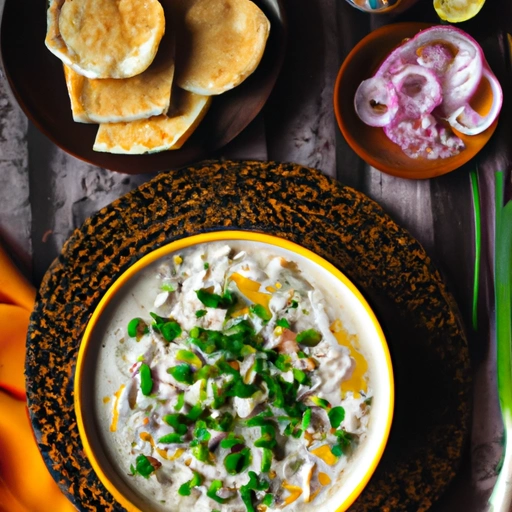Chakka
Chakka Recipe from Uzbekistan: Suzma, Green Onions, Fresh Coriander, Salt
Introduction

Chakka is a traditional Uzbek dish made with suzma, a type of strained yogurt, mixed with fresh herbs and seasonings. This creamy and tangy dish is a popular side dish or appetizer in Uzbek cuisine.
History
Chakka has been a staple in Uzbek cuisine for centuries, with its origins dating back to the Silk Road era. It is believed that the nomadic tribes of Central Asia first created this dish as a way to preserve dairy products during long journeys.
Ingredients
- 500 g (18 oz) suzma
- 0.5 bundle (2 oz (57 g)) green onions
- 0.5 bunch (0.5 oz (14 g)) fresh coriander and dill
- salt to taste
How to prepare
- Grate the suzma thoroughly and place it in a bowl. Mix it with chopped greens, green onions, salt, and pepper.
Variations
- Add chopped tomatoes or cucumbers for a refreshing twist.
- Mix in some garlic or chili flakes for a spicy kick.
Cooking Tips & Tricks
Make sure to grate the suzma thoroughly to achieve a smooth and creamy texture.
- Adjust the amount of salt and pepper to suit your taste preferences.
- Serve chakka chilled for a refreshing and light appetizer.
Serving Suggestions
Serve chakka as a side dish with grilled meats, pilaf, or bread.
Cooking Techniques
Chakka is a no-cook dish that requires only mixing and grating.
Ingredient Substitutions
You can substitute suzma with Greek yogurt or labneh if suzma is not available.
Make Ahead Tips
Chakka can be made ahead of time and stored in the refrigerator for up to 2 days.
Presentation Ideas
Serve chakka in a decorative bowl garnished with fresh herbs or a drizzle of olive oil.
Pairing Recommendations
Pair chakka with flatbread, fresh vegetables, or olives for a complete meal.
Storage and Reheating Instructions
Store leftover chakka in an airtight container in the refrigerator. Serve chilled.
Nutrition Information
Calories per serving
Calories: 150 per serving
Carbohydrates
Carbohydrates: 5g per serving
Fats
Fats: 10g per serving
Proteins
Proteins: 15g per serving
Vitamins and minerals
Chakka is a good source of calcium, vitamin B12, and probiotics.
Alergens
Chakka may contain dairy allergens.
Summary
Chakka is a nutritious dish rich in protein, calcium, and probiotics, making it a healthy addition to your diet.
Summary
Chakka is a delicious and nutritious Uzbek dish made with suzma, fresh herbs, and seasonings. Enjoy this creamy and tangy side dish with your favorite main course for a taste of Central Asian cuisine.
How did I get this recipe?
The first time I saw this recipe, I was captivated by its simplicity. I had always been drawn to traditional dishes that carried with them a sense of history and culture, and this particular recipe for Chakka was no exception. It was a dish that had been passed down through generations in my family, originating from my great-grandmother who had brought it with her from the old country.
I remember watching my grandmother make Chakka in her small kitchen, the aroma of spices filling the air as she deftly chopped vegetables and simmered the stew on the stove. She would tell me stories of her own childhood, of how her mother would make Chakka on special occasions, using only the freshest ingredients from their garden.
As I grew older, I began to help my grandmother in the kitchen, learning the intricacies of the recipe and the importance of each ingredient. The key to a good Chakka, she would say, was in the balance of flavors – the sweetness of the coconut milk, the heat of the chili peppers, and the earthiness of the turmeric.
But it wasn't just the taste of the dish that drew me in. It was the memories and traditions that were woven into each spoonful of Chakka. I could picture my ancestors gathered around a table, laughing and sharing stories as they savored the rich flavors of the stew. It was a dish that connected me to my roots, reminding me of where I came from and the strong women who had come before me.
Over the years, I collected recipes and techniques from various sources – friends, neighbors, and even strangers I met in my travels. Each new version of Chakka that I encountered taught me something new, whether it was a different spice blend or a unique cooking method. I experimented and adapted, combining the old with the new to create my own signature dish.
And now, as I stand in my own kitchen, stirring a pot of Chakka that will soon be shared with my own family, I can't help but feel grateful for the culinary journey that has brought me here. I may have learned to make Chakka from my grandmother, but I have added my own touch to the recipe, making it truly my own.
As I serve the steaming bowls of Chakka to my loved ones, I see the same appreciation in their eyes that I once had when I first tasted this dish. They savor each bite, the flavors transporting them to a time and a place they have never been, but somehow feel connected to. And as they ask for the recipe, eager to recreate it in their own kitchens, I can't help but smile, knowing that the tradition will continue to live on through them.
In the end, Chakka is more than just a dish – it is a story, a memory, a connection to the past. And as long as we continue to pass it down through the generations, it will always hold a special place in our hearts and our bellies.
Categories
| Cilantro Recipes | Dill Recipes | Green Onion Recipes | Uzbek Salads | Uzbekistani Recipes | Yogurt Cheese Recipes |